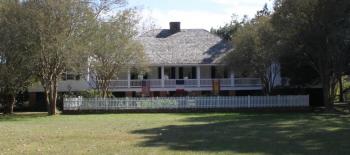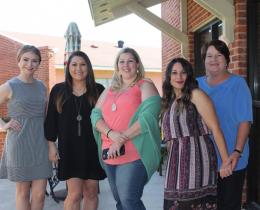
The brick posts of Kent Plantation House in Alexandria are made from clay that had been gathered from the Red River. You can still see the finger prints from the slaves that made these bricks. (Gazette photo by Elizabeth West)
History connection
By: ELIZABETH WEST
Associate Editor
ALEXANDRIA -- When you look out from the second floor balcony of the Kent Plantation House you are able to get a small glimpse of Bayou Rapides. The bayou, that is now nearly completely hidden by busy traffic along the blacktop road in front of it, was once the preferred way of travel for the people in the central Louisiana area.
While the way people traveled was different during the 19th century than it is today, the importance of having the capability to travel has remained the same.
When someone visits the Kent Plantation House, which is the oldest structure still standing in Alexandria having been completed in 1800, their eyes will be opened to the similarities that exist between 19th century Louisiana life and life today. You are able to see how a lot of what we do in the 21st century derived from early settlers just using what George Rogers calls “common sense.”
Rogers, who is a tour guide at the plantation, said, “The amount of taxes someone would pay was based on the amount of rooms you had in your home. Hallways and closets were even counted as rooms that people had to pay taxes on.”
Rogers said, “You know how we use chifferobes today? Well, that came from people using them as closets because a chifferobe could be used as a closet but because it was a piece of furniture and not a room people did not have to pay taxes on it.”
We may not be using our chifferobes to keep us from paying taxes today, but we still can relate to the desire of not paying the amount of taxes expected of us.
When you visit the plantation home, that survived the burning of the city of Alexandria by Union soldiers in during the Civil War in 1865, these chifferobes are present in nearly every room of the home instead of a closet.
The parallels between the lives of Louisiana’s early settlers and the people who call this state home today does not end there, though.
When it came to visitors passing through town the Pierre Baillio family, who was the family that originally had the home built, were sure to show true southern hospitality just like so many of us southerners would show a guest in our home today.
While walking through the two story home, Rogers pointed out a room towards the back of the home on the second floor. This room, Rogers said, was used as a bedroom for visitors passing through the area.
“When visitors passed through town, the family living in the home always made sure to give them a nice place to stay,” said Rogers. “We like to say it was southern hospitality, which I’m sure was some of the reason for giving visitors a room, but these visitors also brought with them news. Visitors had basically become a walking newspaper for people.”
However, in true southern fashion, no polite southerner could tell a visitor when they have over stayed their welcome.
“If a visitor wasn’t leaving on their own, the owner of the home would just go and loosen the ropes that held the visitors mattress up. After a night of trying to sleep on a mattress that sinks to the middle, the visitors were choosing to leave on their own,” said Rogers.
It is through stories like these that people who visit the Kent Plantation House are able to connect life today to the life that many of our ancestors lived 200 plus years ago.
For the portion of life that we today cannot relate to, the Kent Plantation House does its best to provide insight by demonstrating how some of the 19th century period pieces worked.
For instance, the kitchen, which was never attached to a home during this time because of the fear of a fire starting, can be viewed on your tour.
The tour guide thoroughly explains each appliance. From a stove that looks more like a modern day fireplace to a broom made from corn husk, the 19th century kitchen and its appliances look a little different from ours today but yet they still served the same purpose.
Rogers said, “From October to April we plan certain days for open hearth kitchen cooking in the detached kitchen from the home that way people can really get an understanding of what cooking was like.”
The butter that may have been needed for the food cooked in the open hearth kitchen was even made right there on the plantation. While we may understand how amazing butter makes almost any food, many of us today don’t understand what it’s like to churn the butter ourselves. However, a visit to the Kent Plantation House can help you better grasp what it may have been like by allowing visitors to test out one of the plantations very own churns.
It’s the experience of not only becoming more well versed on your Louisiana history, but also the understanding of why we live our lives the way we do that makes a trip to the Kent Plantation House so worth it. Roger said, “These people had a reason for everything that they did and that history plays a part in who we are today.”
- Log in to post comments

